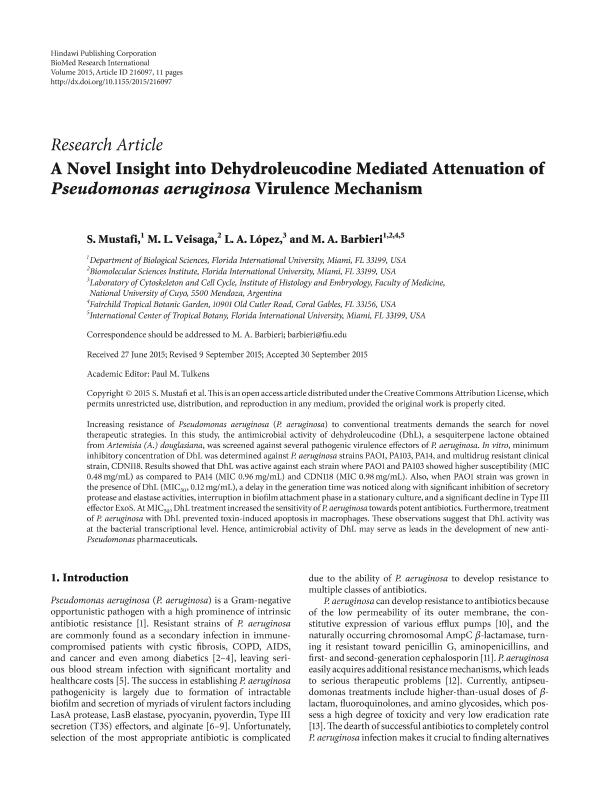Mostrar el registro sencillo del ítem
dc.contributor.author
Mustafi, S.
dc.contributor.author
Veisaga, M. L.
dc.contributor.author
Lopez, Luis Alberto

dc.contributor.author
Barbieri, M. A.
dc.date.available
2018-04-05T20:03:57Z
dc.date.issued
2015-12
dc.identifier.citation
Mustafi, S.; Veisaga, M. L.; Lopez, Luis Alberto; Barbieri, M. A.; A novel insight into Dehydroleucodine mediated attenuation of Pseudomonas aeruginosa virulence mechanism; Indawi; BioMed Research International; 2015; 12-2015; 1-11
dc.identifier.issn
2314-6133
dc.identifier.uri
http://hdl.handle.net/11336/40985
dc.description.abstract
Increasing resistance of Pseudomonas aeruginosa (P. aeruginosa) to conventional treatments demands the search for noveltherapeutic strategies. In this study, the antimicrobial activity of dehydroleucodine (DhL), a sesquiterpene lactone obtainedfrom Artemisia (A.) douglasiana, was screened against several pathogenic virulence effectors of P. aeruginosa. In vitro, minimuminhibitory concentration of DhL was determined against P. aeruginosa strains PAO1, PA103, PA14, and multidrug resistant clinicalstrain, CDN118. Results showed that DhL was active against each strain where PAO1 and PA103 showed higher susceptibility (MIC0.48 mg/mL) as compared to PA14 (MIC 0.96 mg/mL) and CDN118 (MIC 0.98 mg/mL). Also, when PAO1 strain was grown inthe presence of DhL (MIC50, 0.12 mg/mL), a delay in the generation time was noticed along with significant inhibition of secretoryprotease and elastase activities, interruption in biofilm attachment phase in a stationary culture, and a significant decline in Type IIIeffector ExoS. At MIC50, DhL treatment increased the sensitivity of P. aeruginosa towards potent antibiotics. Furthermore, treatmentof P. aeruginosa with DhL prevented toxin-induced apoptosis in macrophages. These observations suggest that DhL activity wasat the bacterial transcriptional level. Hence, antimicrobial activity of DhL may serve as leads in the development of new antiPseudomonaspharmaceuticals.
dc.format
application/pdf
dc.language.iso
eng
dc.publisher
Indawi
dc.rights
info:eu-repo/semantics/openAccess
dc.rights.uri
https://creativecommons.org/licenses/by-nc-sa/2.5/ar/
dc.subject
Dehydroleucodine
dc.subject
Pseudomonas Aeruginosa
dc.subject
Artemisia Douglasiana
dc.subject
Virulence
dc.subject.classification
Otras Ciencias Biológicas

dc.subject.classification
Ciencias Biológicas

dc.subject.classification
CIENCIAS NATURALES Y EXACTAS

dc.title
A novel insight into Dehydroleucodine mediated attenuation of Pseudomonas aeruginosa virulence mechanism
dc.type
info:eu-repo/semantics/article
dc.type
info:ar-repo/semantics/artículo
dc.type
info:eu-repo/semantics/publishedVersion
dc.date.updated
2018-03-27T13:36:31Z
dc.identifier.eissn
2314-6141
dc.journal.volume
2015
dc.journal.pagination
1-11
dc.journal.pais
Estados Unidos

dc.journal.ciudad
Nueva York
dc.description.fil
Fil: Mustafi, S.. Florida International University; Estados Unidos
dc.description.fil
Fil: Veisaga, M. L.. Florida International University; Estados Unidos
dc.description.fil
Fil: Lopez, Luis Alberto. Consejo Nacional de Investigaciones Científicas y Técnicas. Centro Científico Tecnológico Conicet - Mendoza. Instituto de Histología y Embriología de Mendoza Dr. Mario H. Burgos. Universidad Nacional de Cuyo. Facultad de Cienicas Médicas. Instituto de Histología y Embriología de Mendoza Dr. Mario H. Burgos; Argentina
dc.description.fil
Fil: Barbieri, M. A.. Florida International University; Estados Unidos. Fairchild Tropical Botanic Garden; Estados Unidos. Universidad Nacional de Cuyo; Argentina
dc.journal.title
BioMed Research International
dc.relation.alternativeid
info:eu-repo/semantics/altIdentifier/doi/http://dx.doi.org/10.1155/2015/216097
dc.relation.alternativeid
info:eu-repo/semantics/altIdentifier/url/https://www.hindawi.com/journals/bmri/2015/216097/
Archivos asociados
